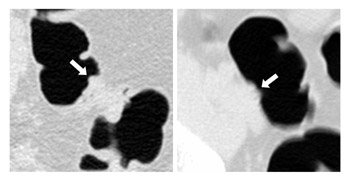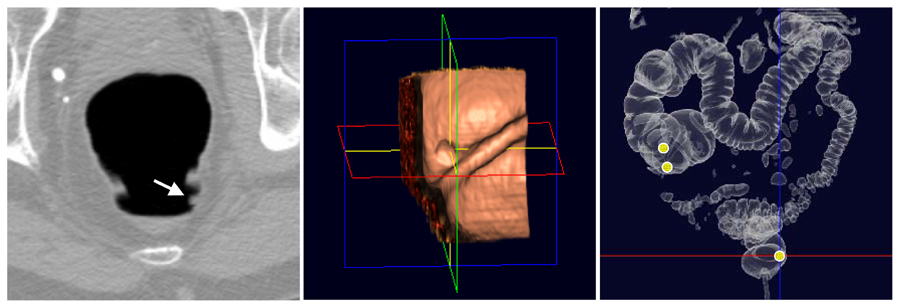Biomedical Imaging
Polyp Detection in CT Colonography: Performance of a CAD Scheme Incorporating 3D MTANNs on False-Negative Polyps in a Multicenter Clinical Trial
We developed computer-aided diagnostic (CAD) scheme for detection of polyps in CT colonography (CTC) and evaluating our CAD scheme with false-negative polyps in a large multicenter clinical trial in collaboration with Don C. Rockey, M.D., the Southwest Medical Center at the University of Texas. A major challenge in CAD schemes for detection of polyps in CTC is the detection of difficultEpolyps which radiologists are likely to miss. Our purpose was to develop a CAD scheme incorporating 3D massive-training artificial neural networks (3D MTANNs) and to evaluate its performance on false-negative (missedE cases in a large multicenter clinical trial. We developed an initial CAD scheme consisting of colon segmentation based on mathematical morphology, detection of polyp candidates based on intensity-based and morphologic feature analysis, and linear discriminant analysis for classification. For reduction of false-positive (FP) detections, we developed a mixtureEof seven expert 3D MTANNs designed to differentiate between polyps and seven types of non-polyps, including folds, stool, the ileocecal valve, and rectal tubes. Our independent database consisted of CTC scans of 614 patients obtained from a large multicenter clinical trial in which 15 institutions participated nationwide. Each patient was scanned in the supine and prone positions with collimations of 1.0-2.5 mm and reconstruction intervals of 1.0-2.5 mm. All patients underwent reference-standardEoptical colonoscopy. One hundred fifty-five patients had clinically significant polyps. Among them, about 45% patients received false-negative interpretations in CTC. For testing our CAD scheme with 3D MTANNs, 14 cases with 14 polyps/masses were randomly selected from the false-negative cases where lesions were visible in both supine and prone scans retrospectively. Lesion sizes ranged from 6-35 mm, with an average of 10 mm. The initial CAD scheme detected 71.4% (12/14) of missedEpolyps, including sessile polyps and polyps on folds, with 18.9 (264/14) FPs per patient. The 3D MTANNs removed 75% (197/264) of the FPs without loss of any true positives; thus, the performance of our CAD scheme was improved to 4.8 (67/14) FPs per patient. With our CAD scheme incorporating 3D MTANNs, 71.4% of polyps missedEby radiologists in the trial were detected correctly, with a reasonable number of FPs. Our CAD scheme would be useful for detecting difficultEpolyps which radiologists are likely to miss, thus potentially improving radiologistsEsensitivity in their detection of polyps in CTC.

Illustrations of polyps missedEby physicians in a multicenter clinical trial. Left: A very small polyp (6 mm) was detected correctly by our CAD system (indicated by an arrow). This polyp was not detected in either CTC or the gold standardEoptical colonoscopy in the trial. Right: A sessile-type polyp (a major source of human false negatives) was detected correctly by our CAD system.

A patient with a small (7 mm) sessile polyp (one of the major sources of false-negative interpretations by radiologists) that was missedEin a clinical trial. (a) our CAD scheme incorporating 3D MTANNs correctly detected the polyp and pointed it by an arrow in an axial CTC image, (b) the polyp in the 3D endoluminal view, and (c) 3D volume rendering of the colon with three computer outputs indicated by yellow circles (one in the rectum is a true-positive detection and the other two are FP detections).

